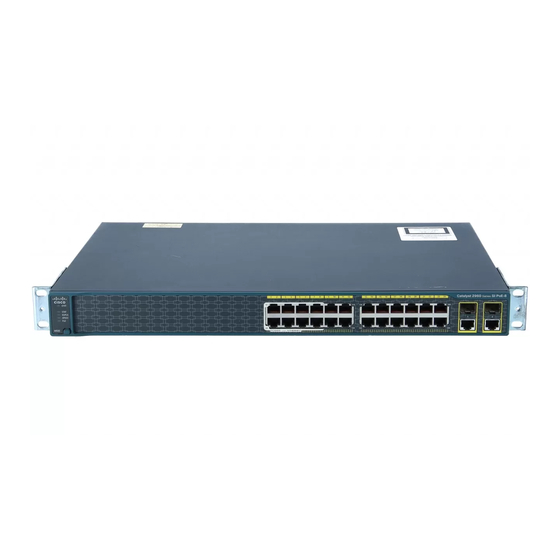
Cisco WS-C2960-24LC-S Manuals
Manuals and User Guides for Cisco WS-C2960-24LC-S. We have 1 Cisco WS-C2960-24LC-S manual available for free PDF download: Software Configuration Manual
Cisco WS-C2960-24LC-S Software Configuration Manual (730 pages)
Software Guide
Brand: Cisco
|
Category: Network Router
|
Size: 7.9 MB
Table of Contents
-
-
Features33
-
-
-
-
-
-
Hostnames102
-
IP Addresses102
-
Passwords103
-
LRE Profiles104
-
-
-
Step 1127
-
Table127
-
-
-
-
-
RADIUS Operation155
-
-
-
Ciphersuites175
-
Device Roles
182 -
-
-
-
-
Token Ring Vlans255
-
Deleting a VLAN259
-
Displaying Vlans263
-
-
Configuring VMPS273
-
Configuring VTP281
-
-
The VTP Domain282
-
VTP Modes283
-
Configuring VTP284
-
VTP Pruning284
-
VTP Version 2284
-
-
Configuring Vtp
286-
-
Domain Names288
-
Passwords288
-
VTP Version288
-
-
Monitoring VTP296
-
-
Configuring STP304
-
-
STP Overview304
-
-
Blocking State308
-
Forwarding State308
-
Learning State308
-
Listening State308
-
Disabled State309
-
-
-
-
-
-
Hop Count329
-
Boundary Ports330
-
-
-
-
-
-
IGMP Versions368
-
Immediate Leave371
-
-
Configuring MVR385
-
-
-
-
-
Configuring UDLD430
-
-
-
Local SPAN434
-
Remote SPAN434
-
SPAN Sessions435
-
Source Ports437
-
Destination Port438
-
Source Vlans438
-
VLAN Filtering438
-
Rspan Vlan439
-
-
-
-
-
-
Configuring SNMP480
-
SNMP Examples491
-
-
-
-
Basic Qos Model503
-
Classification505
-
Mapping Tables511
-
-
-
-
-
-
Ipv6 Addresses572
-
DNS for Ipv6574
-
Icmpv6574
-
SDM Templates576
-
-
Configuring Ipv6577
-
Displaying Ipv6581
-
-
-
-
-
Pagp Modes600
-
LACP Modes601
-
-
-
-
Using Ping630
-
Executing Ping631
-
-
Using TDR635
-
Appendix
641-
Supported Mibs641
-
MIB List641
-
-
-
Appendix
645-
-
Copying Files648
-
Deleting Files649
-
-
Appendix
683 -
Appendix
689-
-
Debug Commands690
-
Miscellaneous692
-
Qos693
-
Radius693
-
Snmp693
-
Spanning Tree694
-
Vlan694
-
Vtp694
-
I N D E X695
-
Advertisement
